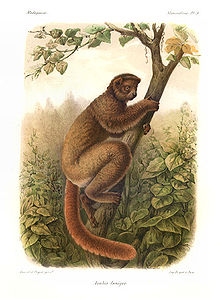Lemurs
| Lemurs | ||||||||||||
|---|---|---|---|---|---|---|---|---|---|---|---|---|

Peyrieras wool lemur ( Avahi peyrierasi ) |
||||||||||||
| Systematics | ||||||||||||
|
||||||||||||
| Scientific name | ||||||||||||
| Avahi | ||||||||||||
| Jourdan , 1834 |
The woolly ( Avahi ) are a primate genus in the family Indriartigen (Indriidae) within the lemurs (Lemuriformes). They are small, nocturnal animals that live in family groups and feed primarily on leaves. There are nine types .
features
Woolly lemurs reach a body length of 25 to 30 centimeters, the tail measures 30 to 37 centimeters and their weight is 0.6 to 1.6 kilograms. They are named after their thick, woolly fur . This is colored red-brown to gray-brown on the top and mostly light gray on the underside. The tail is usually more reddish than the trunk and the inside of the thighs is whitish. The hind legs are significantly longer than the front legs. The head is rounded, the muzzle is short. The face is covered with short hair, which contrasts with the rest of the fur due to its shape and sometimes also due to its color, creating a mask-like appearance. The eyes are large, plump and often surrounded by dark circles - which together with the face mask creates an owl-like appearance. The ears are small and partially hidden in the fur. With a body length of 30 to 45 cm and a weight of 600 to 1200 g, woolly lemurs are the smallest members of their family. Their fur is dense and woolly and usually gray, the limbs are white and the long tail is orange. They have a round head with a short snout, the ears are hidden in the fur.
distribution and habitat
Like all lemurs, woolly lemurs are only found in Madagascar . They inhabit both the dry forests in the west and the rainforests in the east of the island and are often more common in secondary forests .
Lifestyle and diet
In contrast to the other indri-like lemurs, the woolly lemurs are nocturnal, but unlike the other nocturnal lemurs, they look for food together. They usually stay in the trees, where they move vertically climbing and jumping. During the day they sleep close together in the branches or on forks of branches, in contrast to other nocturnal lemurs they do not look for tree holes and do not build leaf nests.
They live in family groups that are made up of a full-grown, monogamous couple and their offspring and can contain up to five animals. They are territorial animals, the territories cover around 1 to 2 hectares and are marked with calls to other groups.
Woolly lemurs feed primarily on leaves, but to a lesser extent they also consume fruits, buds and other vegetable matter. Like many other leaf-eating mammals, they need long periods of rest to compensate for the low nutritional value of their food. The food competition to the often sympatric occurring lemurs they go by out of the way that they eat less common species, their locations and they also defended remember clearly.
Reproduction
The mating takes place in April or May, in September or October the female usually gives birth to a single young. This is carried by the mother during her forays and is not stored in a protected place. The boy is weaned after around six months, and after one to two years it leaves its birth group.
Danger
The main threat to the woolly lemurs is the destruction of the rainforests, and in some areas they are also hunted. Unlike many other primates, they do not hold well in human captivity. However, exact data are not yet available for many of the newly described species.
Systematics
The woolly together with the Sifakas ( Propithecus ), the Indri ( Indri indri ) and some extinct groups, the family of Indriartigen . Clear differences in the way of life to other nocturnal lemurs indicate that they are secondary nocturnal, i.e. that they developed from diurnal ancestors.
The number of known species has increased explosively in recent years. A distinction is currently made between nine types (according to Mittermeier et al., 2008):
- Betsileo wool lemur ( Avahi betsileo )
- Cleese woolly lemur ( Avahi cleesei )
- Peyrieras wool lemur ( Avahi peyrierasi )
- Eastern woolly lemur ( Avahi laniger )
- Southern woolly lemur ( Avahi meridionalis )
- Moore woolly lemur ( Avahi mooreorum )
- Western woolly lemur ( Avahi occidentalis )
- Ramanantsoavana woolly lemur ( Avahi ramanantsoavani )
- Northwestern woolly lemur or sambirano woolly lemur ( Avahi unicolor )
The first three species mentioned live in the dry forests of the west coast, the remaining species in the rain forests of the east coast. In general, the animals on the east coast are somewhat larger and more red in color than the animals on the west coast.
literature
- Nick Garbutt: Mammals of Madagascar. A Complete Guide. Yale University Press, New Haven CT 2007, ISBN 978-0-300-12550-4 .
- Thomas Geissmann : Comparative Primatology. Springer-Verlag, Berlin et al. 2002, ISBN 3-540-43645-6 .
- Russell A. Mittermeier , Jörg U. Ganzhorn, William R. Konstant, Kenneth Glander, Ian Tattersall , Colin P. Groves , Anthony B. Rylands, Andreas Hapke, Jonah Ratsimbazafy, Mireya I. Mayor, Edward Louis jr, Yves Rumpler, Christoph Schwitzer, Rodin Rasoloarison: Lemur Diversity in Madagascar. In: International Journal of Primatology. 29, 2008, ISSN 0164-0291 , pp. 1607-1656.
- Ronald M. Nowak: Walker's Mammals of the World. 6th edition. Johns Hopkins University Press, Baltimore MD 1999, ISBN 0-8018-5789-9 .
